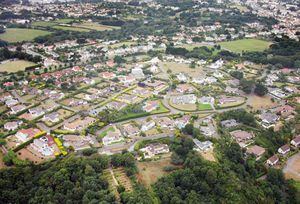When the States steps in
AMONG the predictions for 2021 – although when remains unsure – is an influx of Open Market applicants upon our borders opening.

Weighty tax and residence factors emanating from Brexit and the pandemic are piling on the camel’s back for many high net worth residents in the UK, and further afield, and Guernsey’s business and lifestyle profiles are becoming increasingly attractive, particularly following the national media coverage the island received last year.
Estate agents and tax advisors locally are in regular two-way communication with their counterparts in the UK. Cooper Brouard’s founding partner, Ross Le Marquand, recognises the importance of these centres of influence who, he explains, act as intermediaries on behalf of potential incomers relocating from Britain and more distant shores. Locate Guernsey’s director, Jo Stoddart, is equally busy. As well as Guernsey’s aptitude for business, she says, people are in search of a safe, secure and stable place to live, especially as a consequence of Covid-19. Coincidentally, the Guernsey Press recently reported on the island topping the British charts as one of the best places to live in terms of living conditions and wellbeing, and that survey was taken pre-pandemic.
The number of Open Market sales in 2020 was the highest since 2007. Activity was primarily at the lower end of the sector and chiefly generated from within the island, due to travel restrictions both sides of the Channel impeding property viewings. Free movement will entice more potential buyers into the island, although some prefer to rent first and see the lay of the land before committing to buying a property.
The beginnings of the Open Market can be traced back to February 1948, when the Housing Authority advised the States of Deliberation of an ‘increasingly grave housing situation’ and the need to take ‘far-reaching measures of control’.
Shortages of building materials followed five years of regression during the Second World War, preventing significant development at the time when many people were returning to the island and others were taking up residence for the first time. Measures to protect the island’s limited residential stock included a Housing Control (Emergency Provisions) law, requiring anyone not ordinarily resident to apply for a licence to occupy any Guernsey dwelling. A subsequent Housing Authority report, in 1952, gave the first clear reference to what is now the Open Market register.
Subsequent governmental interventions in our housing markets include the Dwellings Profits Tax (Guernsey) Law, 1975.
The rapid rise in house prices at the time, particularly in the Open Market, saw properties being resold at substantial profits within a few months and even, on rare occasions, within the same month. The DPT levy curbed speculation by imposing a tax of 100% on the profits from the sale of a dwelling or land within 12 months of its purchase and no sale could be completed in conveyancing court without an accompanying DPT clearance certificate.
There were allowances for RPI inflation increases and for legal fees and associated expenses, as well as exemptions on inherited property and for house improvements or developments in line with a building contractor’s normal course of business. In fact, there were coloured forms for every eventuality, which provided an additional facilitator for the States exchequer.
Vendors had to provide a forwarding address and purchasers show a previous domicile, which was useful information in the collection of unpaid personal taxes, as was knowing that significant amounts of money were changing hands. This was irrespective of whether or not the scheduled sale was exempt from Dwellings Profits Tax.
Aside from any question of probity, the law remained in place long after the property boom, until found to be costing more to administer than it recouped in taxes. Nevertheless, it was 34 years before the official suspension of the law, in 2009.
The current surge in the local housing market has prompted calls for government intervention again, but DPT was introduced as a measure against raging inflation and did not halt house prices rising. Neither would it have helped first-time buyers and lowly-paid homeowners in 1980, when house mortgage interest rates rose to 17% (many initial fixed rates have now been in the region of 3% for more than a decade) and again in 1992, when, on ‘Black Wednesday’, the UK withdrew from the European Exchange Rate Mechanism and mortgage interest rates rose to 15%.
There will always be peaks and troughs that disadvantage some people in our housing markets. Besides, the States has already reduced taxes on lower value conveyances, with the introduction of tiered levels of document duty, and abolished document duty altogether on mortgage documents, known as bonds, registered through court.
Then again, a controversial States policy intended to produce affordable housing has failed. Introduced in 2016, the ‘GP 11’ rule states that developments of more than 20 new homes must include affordable units. But none of the affordable units given permission have come from the private sector, due partly but not entirely to market conditions.
This was highlighted in the same report that found Guernsey to be one of the best places to live in Britain, conversely stating that housing expenditure in the island claims on average 24% of household income, placing Guernsey 34th out of 37 in the OECD table.
It is widely contested how detrimental it would be to our age demographics if a significant proportion of younger working islanders left Guernsey solely because of being unable to afford housing.
Guernsey’s population and housing might have changed significantly since that increasingly grave situation in 1948, but remains a matter for concern. As such, last month’s announcement of large-scale development at the former La Fontaine and Belgrave vinery sites was broadly welcomed. Construction could commence in spring 2022 on what is potentially between 125 and 313 new dwellings on the adjoining sites, which the States purchased in the mid-1980s for a total of £400,000.
The Development Framework includes an area of neighbouring land, subject to negotiation with its owner, and will include a large proportion of social and affordable housing, including partial ownership schemes, fashioned and administered by the States-allied Guernsey Housing Association.





